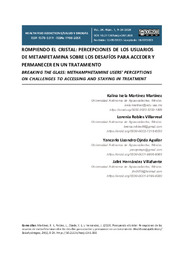Por favor, use este identificador para citar o enlazar este ítem:
https://hdl.handle.net/11000/32036Registro completo de metadatos
| Campo DC | Valor | Lengua/Idioma |
|---|---|---|
| dc.contributor.author | Martínez Martinez, Kalina Isela | - |
| dc.contributor.author | Robles Villarreal, Lorenia | - |
| dc.contributor.author | Ojeda Aguilar, Yancarlo Lizandro | - |
| dc.contributor.author | Hernández Villafuerte, Jafet | - |
| dc.contributor.other | Departamentos de la UMH::Psicología de la Salud | es_ES |
| dc.date.accessioned | 2024-05-03T06:39:29Z | - |
| dc.date.available | 2024-05-03T06:39:29Z | - |
| dc.date.created | 2024-02-22 | - |
| dc.identifier.citation | Health and Addictions Journal/Salud y Drogas Vol. 24 Núm. 1 (2024) | es_ES |
| dc.identifier.issn | 1988-205X | - |
| dc.identifier.issn | 1578-5319 | - |
| dc.identifier.uri | https://hdl.handle.net/11000/32036 | - |
| dc.description.abstract | Introducción. La demanda de oferta terapéutica por consumo de metanfetamina (cristal) en el estado de Aguascalientes, México se ha incrementado en los últimos años. El cristal se ha convertido en la principal droga de impacto en consumidores de Aguascalientes. La mayoría de las personas que van a tratamiento, lo hacen en servicios no gubernamentales emanados de la sociedad civil, conocidos como centros residenciales o anexos. Método. Se llevó a cabo un estudio para identificar y analizar las barreras que enfrentan los consumidores de cristal al buscar tratamiento. Se realizaron 21 entrevistas a personas consumidoras de cristal que recibían tratamiento en tres centros residenciales. Resultados. Se identificaron trestipos principales de barreras:sistemáticas o estructurales, no sistemáticas o actitudinales y de permanencia o adherencia al tratamiento. Conclusiones. El estudio destaca la importancia de identificar los obstáculos que enfrentan las personas consumidoras para acceder a algún tipo de tratamiento, así como identificar y analizar los componentes que deberían incluirse en el diseño de programas de prevención e intervención que se adecuen a las necesidades de este tipo de consumo en específico. | es_ES |
| dc.description.abstract | Introduction. The demand for therapeutic treatment for methamphetamine (crystal) consumption in the state of Aguascalientes, México hasincreased in recent years. Crystal has become the primary drug of impact among consumers in Aguascalientes. The majority of people who seek treatment do so in non-governmental services emanating from civilsociety, known asresidential centers or annexes. Method. A study was conducted to identify and analyze the barriers faced by crystal consumers when seeking treatment. 21 interviews were conducted with crystal consumersreceiving treatment at three residential centers. Results. Three main types of barriers were identified: systematic or structural, non-systematic or attitudinal, and retention or adherence to treatment. Conclusions. The study highlights the importance of identifying the obstacles that consumers face in accessing treatment, as well asidentifying and analyzing the componentsthatshould be included in the design of prevention and intervention programs that are tailored to the specific needs of this type of consumption. | es_ES |
| dc.format | application/pdf | es_ES |
| dc.format.extent | 16 | es_ES |
| dc.language.iso | spa | es_ES |
| dc.publisher | Universidad Miguel Hernández de Elche | es_ES |
| dc.rights | info:eu-repo/semantics/openAccess | es_ES |
| dc.rights | Attribution-NonCommercial-NoDerivatives 4.0 Internacional | * |
| dc.rights.uri | http://creativecommons.org/licenses/by-nc-nd/4.0/ | * |
| dc.subject | Cristal | es_ES |
| dc.subject | Barreras | es_ES |
| dc.subject | Tratamiento | es_ES |
| dc.subject | Usuarios de cristal | es_ES |
| dc.subject | Centros residenciales | es_ES |
| dc.subject | Crystal meth | es_ES |
| dc.subject | Barriers | es_ES |
| dc.subject | Treatment Cristal users | es_ES |
| dc.subject | Cristal users | es_ES |
| dc.subject | Residential centers | es_ES |
| dc.subject.other | CDU::1 - Filosofía y psicología::159.9 - Psicología | es_ES |
| dc.title | Rompiendo el cristal: percepciones de los usuarios de metanfetamina sobre los desafíos para acceder y permanecer en un tratamiento | es_ES |
| dc.title.alternative | Breaking the glass: methamphetamine users’ perceptions on challenges to accessing and staying in treatment | es_ES |
| dc.type | info:eu-repo/semantics/article | es_ES |
| dc.relation.publisherversion | https://doi.org/10.21134/haaj.v24i1.868 | es_ES |

Ver/Abrir:
888-Texto del artículo anonimizado-5622-4-10-20240222.pdf
484,68 kB
Adobe PDF
Compartir:
 La licencia se describe como: Atribución-NonComercial-NoDerivada 4.0 Internacional.
La licencia se describe como: Atribución-NonComercial-NoDerivada 4.0 Internacional.
.png)